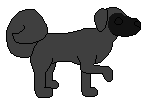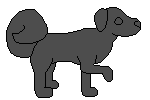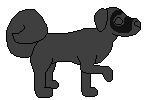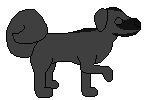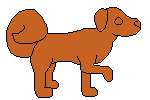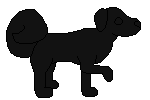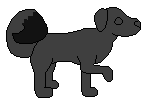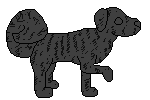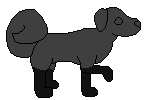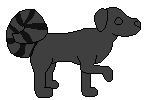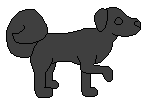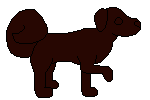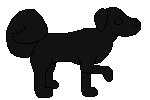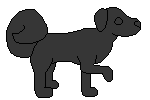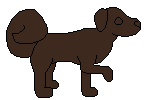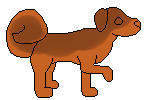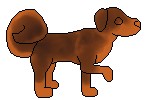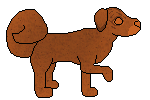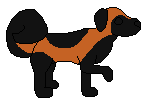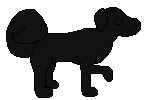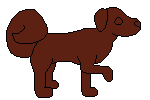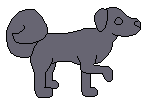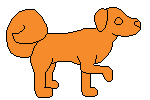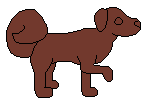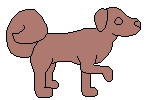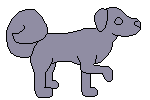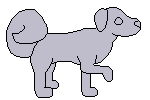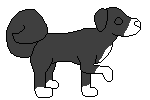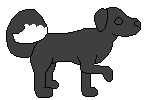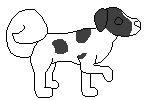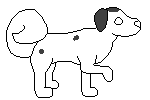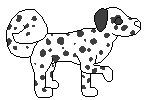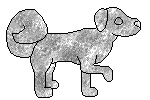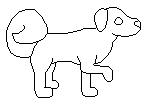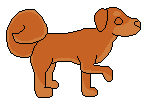If you'd like a genetics crash course, you've come to the right place, otherwise feel free to move on. There will be written out gene types listed in the next post as well as example combinations below that!

If you're still here, hi hello! I want to first start off by saying I'm not a scientist and my general knowledge comes from observation and about 3 days of research into dog genetics lol. At the end of the day, I altered things to make sense in my brain while still doing my best to make them semi-scientifically accurate.
Genes always come in pairs. So one dog carries two types of a gene within each locus. These genes can be the same or different!
Genes are either dominant, co-dominant, or recessive. If they're dominant, they win out over other genes. If they're co-dominant, they may combine to make an in-between version of that gene (think a gene for a black coat and a gene for a white coat causing a grey coat). If a gene is recessive, it won't present itself unless there are two of that recessive gene present.
When two dogs breed, they each offer their genes into the pool for each Locus type. If parent A has EmEam for their E Locus, and Parent B has EdE then the pup may have either EmEd, EmE, EdEam, or EamE as the result. (Feel free to Google Punnet squares for a visual example of this!).
Now here's the more complex stuff. This information isn't as important if you just wanted a base understanding of how genetics may impact your dog's appearance/how puppies may look. What I'm gonna throw out now is more information about how genes determine colors and why our genes are ordered this way!
ALRIGHT SO - dog coat genes (for color) have two components: eumelanin and pheomelanin. Eumelanin is the "base" coat and is most often black or brown (with some breeds being theorized to have dark red eumelanin due to a mutation). This color impacts the dogs paw, nose, and eye color along with coat color.
Pheomelanin, on the other hand, is the "lighter" tones of a dog usually consisting of reds, yellows, and creams. This color doesn't impact the paws, nose, or eyes and is often considered to be placed "on top of" a base coat when coloring a dog, though this isn't always the case.
Dog hair strands aren't always a singular color! This is where the term agouti comes in. Agouti refers to banding on a dog's hair, resulting in different colors in one spot. The best examples of this are wolf coats, huskies, and sable-colored dogs like a sable German Shepherd.
Finally -
a crash course in each Locus type and how we define them for Highland Pointers.Our Locus are put in order of dominance and in order of how they interact with each other. (Is this the scientifically correct order? I don't know! But this is the order that made the most sense to my silly brain)
(This breed doesn't have merle or harlequin present within it! Those are two real Locus-types for dog markings. So even though, in theory, they'd have the genotype present, we will not be including it for simplicity sake!)
Coat Color Genes
E Locus - "Extension" This gene primarily impacts eumelanin production. This locus often is the source of "mask" markings in dogs, but can also decrease eumelanin, or make it not present at all.
K Locus - "Dominant black" This gene adds eumelanin-based markings to the dog. This gene is also responsible for a dog being all black (or black with only white markings).
B Locus - "Brown" This gene is responsible for the color of the eumelanin in a dog with the options being black, brown, or a deep red (which stems from a mutation to the gene that's present in Highland Pointers).
D Locus - "Dilute" This gene can lighten the color of the B Locus/eumelanin. This makes black become silver, brown become lilac, and red become ginger.
A Locus - "Agouti" This gene impacts eumelanin and pheomelanin by decreasing eumelanin production to allow pheomelanin to express. This gene can be covered by the K Locus when applicable. The term "agouti" refers to when a single strand of hair naturally produces more than one color, resulting in color bands on the hair.
P Locus - "Pheomelanin" This gene impacts pheomelanin base color. The three primary hues are reds, tans, and blues.
I Locus - "Intensity" This gene influences the lightness of the pheomelanin in a dog. This can be most often noticed in golden retrievers (this gene causes the lighter color ones) and in Chihuahua's (causes the black/cream color combo).
S Locus - "Spotting" This gene causes white markings to be produced. White markings will prevail even in a dog that is solid in color otherwise.
F Locus - "Flecking" This gene causes the production of white spots in otherwise pigmented areas. Unlike white produced by the S Locus, this white is dominant, meaning roan and ticking won't be produced in areas colored by the flecking gene.
T Locus - "Ticking" This gene adds pigment back to otherwise white areas, specifically those caused by the S Locus. If there is no white present on the dog, this gene can still be carried but won't be visible.
U Locus - "Urajiro" Well known in the Shiba Inu breed, this gene specifically influences pheomelanin and causes lightening in certain areas of it, without lightening all of the pheomelanin present. This is another gene that can be present without being visible should a dog not have pheomelanin visible.
Coat Texture Genes
L Locus - "Length" This gene impacts the length of the fur of a dog.
R Locus - "Texture" This gene impacts if a dog's fur is straight, wavy, or curly.
Body Shape Genes
V Locus - "Ears" This gene determines if a dog has V-flop ears, cocked ears, or pointed ears.
C Locus - "Tail Curl" This gene determines if a dog has a curled tail or a straight tail.



